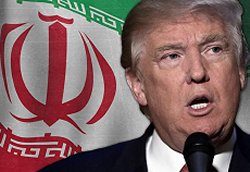
|
- Iran: Eight Prisoners Hanged on Drug Charges
- Daughter of late Iranian president jailed for ‘spreading lies’ - IRAN: Annual report on the death penalty 2016 - Taheri Facing the Death Penalty Again - Dedicated team seeking return of missing agent in Iran - Iran Arrests 2, Seizes Bibles During Catholic Crackdown
- Trump to welcome Netanyahu as Palestinians fear U.S. shift
- Details of Iran nuclear deal still secret as US-Tehran relations unravel - Will Trump's Next Iran Sanctions Target China's Banks? - Don’t ‘tear up’ the Iran deal. Let it fail on its own. - Iran Has Changed, But For The Worse - Iran nuclear deal ‘on life support,’ Priebus says
- Female Activist Criticizes Rouhani’s Failure to Protect Citizens
- Iran’s 1st female bodybuilder tells her story - Iranian lady becomes a Dollar Millionaire on Valentine’s Day - Two women arrested after being filmed riding motorbike in Iran - 43,000 Cases of Child Marriage in Iran - Woman Investigating Clinton Foundation Child Trafficking KILLED!
- Senior Senators, ex-US officials urge firm policy on Iran
- In backing Syria's Assad, Russia looks to outdo Iran - Six out of 10 People in France ‘Don’t Feel Safe Anywhere’ - The liberal narrative is in denial about Iran - Netanyahu urges Putin to block Iranian power corridor - Iran Poses ‘Greatest Long Term Threat’ To Mid-East Security |
Tuesday 28 June 2011Iran’s Women Two Years after the Uprising
Mahboubeh Abbasgholizadeh, a women’s rights activist, is a founding member of the Stop Stoning to Death Campaign and the Iranian Women’s Charter. She was director of Entesharat-e Banoo (Banoo Publications) and Entesharat-e Jamee Iranian (Iranian Society Publication). She was the director of the Association of Women Writers and Journalists NGO. She is currently a Reagan-Fascell Democracy Fellow at the National Endowment for Democracy. Human rights organizations have reported around 300 female political prisoners since the Green Movement’s emergence two years ago. The accuracy of this statistic is uncertain since some women have chosen not to publicize their arrests. * On what grounds have female political prisoners been arrested? They have been accused of being a threat to national security. The regime targets activists from all spheres who can in some way keep social movements alive. The regime does not want the Green Movement to benefit from any other movements. The regime has always targeted women’s rights activists but the rate greatly increased after the emergence of the Green Movement. * Women were at the forefront of the 2009 demonstrations that produced the Green Movement. What is the current status of the women’s movement two years later? Since Iran’s 2009 presidential election, the women’s movement has focused on the status of female political prisoners and the daily government crackdowns. Women’s rights activists have broadened their human rights efforts. They are pursuing their cases not just in Iranian courts, but also in the international arena in their attempt to confront state violence with non-violence. * Have the women’s rights campaigns changed since two years ago? The Green Movement and the women’s movement have influenced each other. Before the Green Movement, the latter focused only on gender equality. * What is the status of the One Million Signatures Campaign, which seeks to collect one million signatures to change discriminatory laws against women in Iran? The campaign is still functioning but has had to change tactics. It now functions underground because of the heightened government crackdown. Many of the campaign’s members have also become active in the Green Movement, helping to further democratize the opposition. Source: The Iran Primer |






